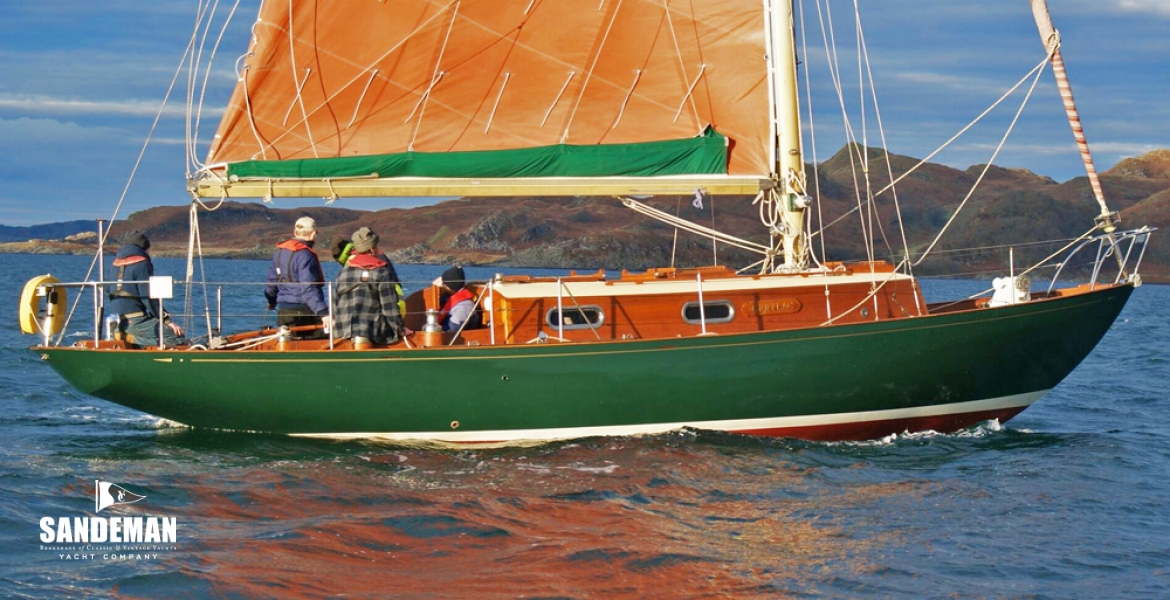
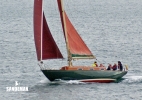
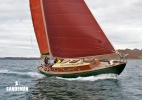
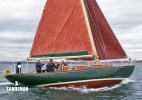
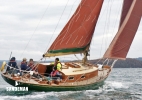
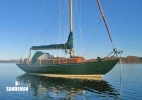
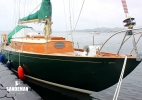
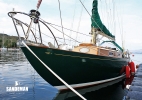
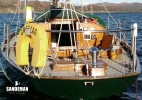


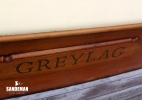
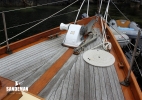
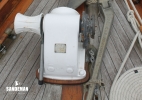

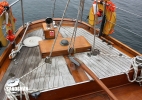
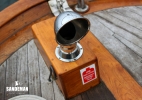
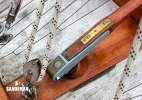
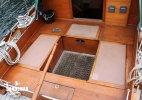
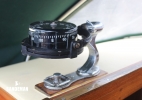
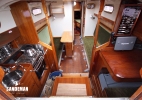
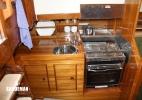
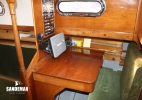
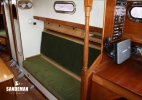
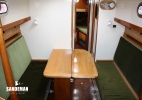
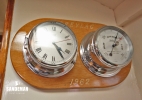
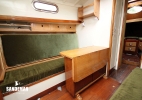
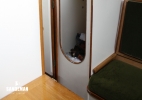
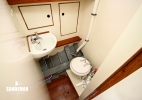
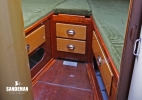
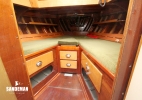
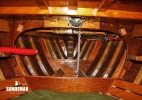
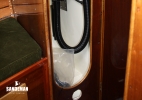
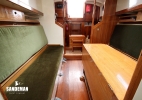
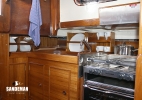
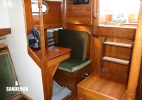
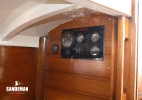
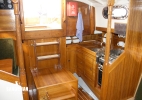
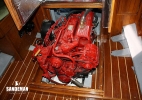
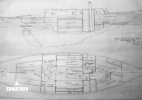
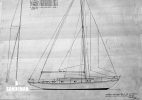
| Designer | David Boyd |
|---|---|
| Builder | Alex Robertson & Sons, Sandbank, Scotland |
| Date | 1962 |
| Length overall | 37 ft 8 in / 11.48 m |
| Length deck | 37 ft 8 in / 11.48 m |
| Length waterline | 25 ft 6 in / 7.77 m |
|---|---|
| Beam | 10 ft 3 in / 3.12 m |
| Draft | 5 ft 8 in / 1.73 m |
| Displacement | 10 Tonnes |
| Construction | Laminated mahogany frames |
| Engine | Beta 35 HP Diesel 2004 |
|---|---|
| Location | United Kingdom |
| Price | Sold |
These details are provisional and may be amended
GREYLAG is a Bermudan rigged cruising yacht of timber construction designed along fairly traditional hull lines. She has a raked, rounded stem and cut away forefoot angling down into a long keel, with a lead ballast section externally fitted. The rudder is angularly mounted at the aft end of the keel with stern gear to port side carrying a three-bladed bronze propeller. The yacht has sweet, rounded hull lines carrying reasonable freeboard and beam for her overall length, with a long counter stern.
Interested in GREYLAG in more detail.
In May 1962 GREYLAG was commissioned by Colonel William Henry Whitbread - Brewer and variously a member of the Royal Yacht Squadron, The Royal Cork Yacht Club, The Royal Thames and the Western Isles.
During his ownership GREYLAG was loaned to Francis Chichester circa 1965 before starting his final round the world trip on Gypsy Moth IV in August 1966 – to give him something to sail whilst he waited for the completion of his own yacht. Chichester had put steering gear on her stern and sailed her single-handed to Cork apparently breaking some record on the way. She was at some stage dismasted off the Irish Coast and a new mast was built for her by Robertson's and sent by lorry to Crosshaven. Unfortunately the lorry swung in to the gate entering the boatyard, caught the mast and broke it. Thereafter the Insurers would only agree to fit the present aluminium mast.
Col Whitbread’s daughter Sarah Freemantle thought the vessel had been sold to Lord Shawcross and while this is not certain; he may have borrowed her as she is in Whitbread’s ownership in 1975 and then on Lloyds Register still listed as 100A1.
Subsequent owners and key events
June 1976 Robert Muir engineer and Christian Muir of Strathblane, Stirling
Feb 1985 Engine change
July 1986 Colin Wilkinson company director of Penwortham, Preston Lancs
Nov 1987 William McKenna Solicitor; Carlisle and William Walker insurance broker; Corbridge
Feb 1995 Ian Robertson company director; Glasgow
Dec 2002 Dr S G Potts MD Lauder, Berwickshire
June 2012 Crinan Boatyard, Lochgilphead Argyll
April 2016 Small vessel certified through the YDSA cert Y16SV0115779
Permits up to 60 nm from UK safe haven or on an international voyage and only to operate in UK ports.
- Carvel 15/16th inch splined mahogany hull planking
- Laminated mahogany frames
- 2 steam bent oak frames between
- Galvanised steel floors and straps
- Deck planking ¼ inch ply & 5/8th inch teak
- Teak and holly marine ply cabin sole
- Teak veneered marine ply joinery in the galley area
- Marine ply bulkheads with some painted and some varnished
- Mahogany trimmed and faced marine ply in fwd cabin with solid oak drawers and facing
- Oak Pullman berths in the saloon with varnished locker faces and table
From aft
- Stainless steel pushpit
- Stainless steel stanchions with guardrails running forward
- 1 x Chromed vent on dorade box
- Varnished lazarette hatch with bronze mushroom vent
- Chromed fairleads each side
- 2 x Teak and bronze cleats
- 2 x Main sheet winches on pedestals
- Hinged tiller
- 2 x Lewmar 42, 2 speed winches on pedestals
- 2 x Lewmar 44, 2 speed ST winches on pedestals,
- High varnished cockpit coamings
- Lifting seats each side over lockers below
- Grated raw teak sole
- Bridge deck
- Trunk cabin with sliding hatch to companionway
- Varnished teak handrail on coach roof each side
- Sestrel steering compass on coach roof
- Barlow 15 winch to starboard
- Spray screen
- Foresail tracks outboard on cap rail each side
- Mounting for life raft on centre line
- Skylight hatch on centre line
- Chromed vent to stbd
- 2 x foresail tracks on deck each side
- Mast
- Fore hatch forward end of trunk cabin
- Foredeck
- SL Francis 800 anchor windlass with capstan and warping drum
- Galvanized 35 lb CQR anchor with 60 m chain
- Teak and bronze mooring cleats each side
- Stainless steel pulpit
- Bow rollers and fairlead to stbd
Sliding hatch in coach roof and companionway steps down over engine casing
Light and airy cabin with white painted deck head and bulkheads
Contrasting varnished mahogany joinery
Galley to port
- Stainless steel sink with stowage lockers and shelves outboard and aft
- Cupboards under sink
- Gimballed Techimpex 2 hob gas cooker, oven and grill
Chart table stbd
- Pilot’s seat aft
- Lifting chart table with stowage below
- Electrical and navigation instruments
Saloon forward
- Drop-leaf table offset to port
- Port lights
- Bulkhead lights
- Clock and barometer on stbd bulkhead fwd
Head compartment to port
- Porcelain wash basin with hot and cold water
- Baby Blake manual pump WC
- Stowage in lockers outboard
Fore cabin
- Single vee berths with locker storage below
- Hatch over in coach roof
Sloop rig
- Gold anodised aluminium alloy spars
- 1x19 stainless steel standing rigging
- Profurl foresail furler
- 2 x Antal W30 ST halyard winches on mast
Sails by Owen Sails in tan Terylene
- Main
- Headsail and main sail bag from 2000
Rig and sails serviceable but age of rig and main sail unknown
- Beta 35 HP Diesel 2004
- 3 Bladed bronze propeller offset from centreline
- 60 A engine driven alternator
- 2 x 120 A 12 V batteries charged via battery master switch
- 18 litre calorifier warmed by engine immerser - not fitted
- Eberspacher D3 cabin heating with ducting to saloon and fwd cabin areas
- Original galvanised steel fresh water tank, 40 gallons / c 180 litres under saloon sole
- Stainless steel fuel tank, 10 gallons / c 45 litres
- 2 x 4.5 kg gas bottles
- Hot and cold water pump in head and galley
- Sea water foot pump also in galley
- Raymarine i50 Tridata display
- Raymarine i60 windpack
- Raymarine B45 depth transducer
- Raymarine bronze speed/log transducer
- Raymarine C80 chart plotter
- Icom DSC Radio
- iC/M323G GPS
- Fire blanket in galley
- Sea safe pro-lite life raft, 4 pax Jun 2016
- Horseshoe buoy
- Manual double acting bilge pump
- Electric submersible bilge pump on float switch
- BEP gas protector safety alarm with solenoid at the bottles
- Jackstays on deck
Stem
The rotten inner stem laminations, eight feet down from the stem head, have been removed. New mahogany laminations have been made and glued in with epoxy, and the whole area thoroughly soaked with five-star Cuprinol.
A strong internal backing piece for the stem, in 1 ½ inch oak, from the stem head down to the first steel floor, has been steamed in and epoxied to the stem itself. This has been through bolted to further support the newly laminated stem.
A new stem head was built up, and shaped to the original pattern, to suit the stem-head roller.
Rotten sections from four planks on port side, and five on starboard were cut out, and replacements scarfed in, with well-staggered joints for strength.
Cappings, bulwarks and bulwark doublers for about four feet back from stem were removed, to access the covering boards and structure underneath and later replaced.
The teak deck covering boards in way of stem were removed, rotten sections at the forward ends of port and starboard beam shelves and packers and forward-most steamed frames, also of the breast hook, were removed and replacement pieces scarfed in with epoxy glue. The whole area was liberally treated with five-star Cuprinol with fresh applications over the period of a week and the original covering boards replaced.
Laminated and steamed oak frames
Almost all the laminated frames throughout the boat have been drilled and injected with epoxy, as far as possible and at the same time strengthened with heavy-gauge copper boat nails driven right through and clenched with roves, through the centre of every plank.
Two cracked oak frames have been sistered with new laminated frames. About five cracked frames on the starboard side, and seven on the port side, below and forward of the engine, have also been sistered with new steamed oak frames, through-fastened with clenched copper boat nails or fastened with bronze screws, where there was no access for clenching.
Cockpit area
In an ill-advised and poorly executed re-fitting 20 years ago, the structural bulkheads on both sides at the aft end of the cabin, had been removed to make a pilot berth on the starboard side and to allow the building of a larger galley with big ice-box on the port side, using unsuitable materials. This had weakened the forward end of the cockpit.
The re-fitted galley and bulkheads were in very poor condition and have now been removed.
Most of the main beam was cut out from below and a replacement section scarfed in, fastened with heavy gauge bronze screws and epoxy glue.
New full height marine-ply bulkheads were fitted below the aft cabin-end, on both sides of companionway. A substantial post in teak was also fitted to the bulkhead on the starboard side for extra strength. This was unnecessary on the port side given the strong point created by the junction of the new transverse and fore-and-aft bulkheads.
Rotten areas of the starboard carlin were cut out from below, replaced with new sections in oak and glued with epoxy. Strong posts were also fitted at the aft corners of the cockpit, down to the stringer, for added strength.
Beadings fitted to ensure the water-tightness of the inner cockpit coaming joints and any joints in the cockpit which had widened slightly routed out and sealed with teak fillets.
Hull below engine area
Two laminated frames had been damaged by the fastenings for the original steel engine beds. One of these frames has been replaced by a new laminated frame glued with epoxy and the other opened up and re-glued with epoxy.
The original engine beds themselves, which were in poor condition and unsuitable for the current engine, were removed and replaced with a new structure in heavy-gauge galvanised steel, which combined new engine beds with close fitted webbed steel strap-frames; through-bolted on three of the pairs of laminated frames, making this whole area much stronger and more rigid than in the original build.
Other structural work
Some small cracking to the planking close to the cockpit has been repaired with closely fitted butt-blocks, screwed and glued.
All bolts in the smaller steel floors / strap frames were replaced with new galvanised bolts. A number of bolts in the larger frames, which were generally in better condition, were withdrawn for inspection. Any bolts which showed signs of serious corrosion either inside, or where the wood showed signs of deterioration outside, were also replaced. All the bolts were replaced in the steels strap. All keel bolts were checked for tightness.
All steel strap frames / floors were chipped and wire brushed to remove rust and treated with rust inhibitor and Galvafroid paint.
Work on the outside of the hull
Any plugs over fastenings deemed unsound were drilled out, the fastenings themselves replaced with new bronze screws and new plugs fitted. Any local areas of deterioration in the planking, such as areas of cracking around the fastenings were made good with graving pieces, glued in with epoxy.
Two strong iroko straps were routed in, epoxied and through-bolted, to support the joint in the keel timbers close to the lower rudder support. Two further iroko straps were fitted to strengthen a worn area in the false keel aft of the ballast keel and a similar repair was made to strengthen the timber around the stern tube.
The galvanised rudder stock has been withdrawn, cleaned, re-galvanised and replaced and the rudder extensively repaired and re-faired. The rudder fittings have been cleaned and strengthened where necessary.
Loose splines in the plank joints have been replaced, either with new splines or where appropriate, with epoxy.
All underwater planking joints have been raked out and re-puttied.
Fitting out work
A new removable bulkhead has been fitted below the companionway. New cabin sole bearers and new cabin sole on two levels, have been fitted around the engine and in the galley area; the cabin sole of teak with holly strips. New cabin sole bearers have also been fitted in the saloon; the original solid teak cabin sole repaired and re-fitted and an extra piece fitted, to replace those shortened or damaged during the previous re-fitting.
The bulkhead between the galley and the saloon had been moved forward during the previous re-fitting to the extent of two frames from its original position, in order to incorporate the enlarged galley, which made the port saloon bunk extremely short. This bulkhead has been removed and replaced by a new bulkhead in 16 mm teak-faced marine ply. It has been moved aft by one frame in order to restore the bunk to an acceptable length and at the same time provide a larger cabin sole area beside the galley. New cappings and an upright post have been fitted to match those on the starboard bulkhead, and the post has been turned to the same pattern of the starboard one.
A complete new engine box has been fitted in teak-faced marine ply and a new set of teak companionway steps. A new teak capping has been fitted to the port saloon bunk and many other minor internal repairs made.
Finishing
Most of the external varnished areas have been sanded and re varnished. Bilges and the inside of the hull have also been scraped and re-treated with suitable primer and paint. All bulkheads and most other internal surfaces have also been scraped, sanded and re-finished.
Contact us to discuss GREYLAG in more detail.
These particulars have been prepared from information provided by the vendors and are intended as a general guide. The purchaser should confirm details of concern to them by survey or engineers inspection. The purchaser should also ensure that the purchase contract properly reflects their concerns and specifies details on which they wish to rely.